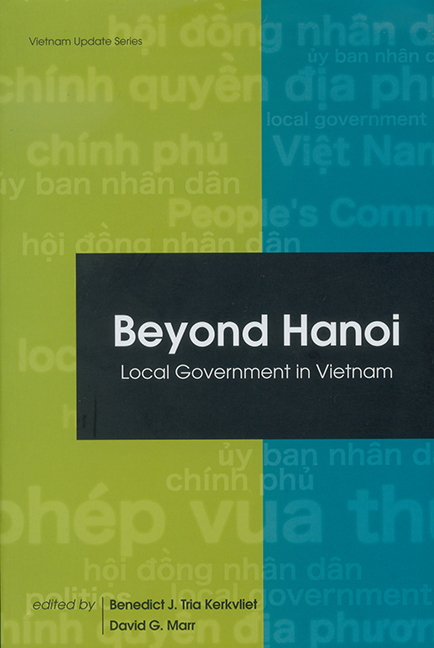Book contents
- Frontmatter
- Contents
- Preface
- Abbreviations
- 1 Surveying Local Government and Authority in Contemporary Vietnam
- 2 A Brief History of Local Government in Vietnam
- 3 Village Government in Pre-colonial and Colonial Vietnam
- 4 Caught in the Middle: Local Cadres in Hai Duong Province
- 5 Winter Crop and Spring Festival: The Contestations of Local Government in a Red River Delta Commune
- 6 Local Politics and Democracy in a Muong Ethnic Community
- 7 Local Government in the Exercise of State Power: the Politics of Land Allocation in Black Thai Villages
- 8 Urban Government: Ward-level Administration in Hanoi
- 9 The Facilitators of Rural Transformation and Development: The Role of Agricultural Extension Officers in Two Districts of Long An Province
- 10 Ho Chi Minh City's Post-1975 Political Elite: Continuity and Change in Background and Belief
- 11 Push, Pull, and Reinforcing: The Channels of FDI Influence on Provincial Governance in Vietnam
- Glossary of Vietnamese Terms
- Index
- About the Contributors
2 - A Brief History of Local Government in Vietnam
Published online by Cambridge University Press: 21 October 2015
- Frontmatter
- Contents
- Preface
- Abbreviations
- 1 Surveying Local Government and Authority in Contemporary Vietnam
- 2 A Brief History of Local Government in Vietnam
- 3 Village Government in Pre-colonial and Colonial Vietnam
- 4 Caught in the Middle: Local Cadres in Hai Duong Province
- 5 Winter Crop and Spring Festival: The Contestations of Local Government in a Red River Delta Commune
- 6 Local Politics and Democracy in a Muong Ethnic Community
- 7 Local Government in the Exercise of State Power: the Politics of Land Allocation in Black Thai Villages
- 8 Urban Government: Ward-level Administration in Hanoi
- 9 The Facilitators of Rural Transformation and Development: The Role of Agricultural Extension Officers in Two Districts of Long An Province
- 10 Ho Chi Minh City's Post-1975 Political Elite: Continuity and Change in Background and Belief
- 11 Push, Pull, and Reinforcing: The Channels of FDI Influence on Provincial Governance in Vietnam
- Glossary of Vietnamese Terms
- Index
- About the Contributors
Summary
Vietnam's political culture has long combined firm ideological dispositions towards centralization of power with practical recognition of local particularities and responsibilities. In this chapter I offer a preliminary view of governmental relations from the village level upward, beginning in the 15th century AD, proceeding through the French colonial period (1885–1945), and concluding with early developments under the Democratic Republic of Vietnam (1945–1976). The story could begin much earlier, but the historical traces are less plentiful, and the Viet (Kinh) people had yet to move down the coast beyond Nghe An. I also say little about government at the centre (trung uong), as that story is better known, and in any event would take us away from the focus of this book.
Pre-colonial local government
During almost a thousand years of independent monarchism (939–1885 AD), the emperor sat at the apex of a pyramid of princes, courtiers, military commanders and civil officials — all of whom demanded obedience from common subjects. For at least half that time, local government was intertwined with the operation of large estates controlled by the royal family, aristocrats, and Buddhist temples. Gradually, however, the state administrative hierarchy took on more tasks. In 1490, Emperor Le Thanh Ton restructured his realm into thirteen regions (xu), 52 prefectures (phu), 50 sub-prefectures (chau; usually inhabited by non-Kinh people), 178 districts (huyen), 6851 communes (xa) and 1155 other units of diverse designation. Although this administrative terminology was borrowed entirely from China, Vietnamese usage often proved different. Another major reorganization occurred in 1831, when Emperor Minh Mang delineated 31 provinces (tinh), 75 prefectures, 249 districts, several thousand cantons (tong) and more than 12,000 communes, villages or village-type settlements (xa, thon, dong, sach). By this time, Vietnam had more than doubled in territory and quadrupled in population, imposing additional governmental challenges.
The tyranny of Vietnam's geography determined that officials posted more than a hundred kilometres or so from the royal capital possessed considerable administrative discretion.
- Type
- Chapter
- Information
- Beyond HanoiLocal Government in Vietnam, pp. 28 - 53Publisher: ISEAS–Yusof Ishak InstitutePrint publication year: 2004

